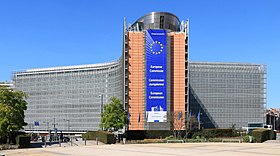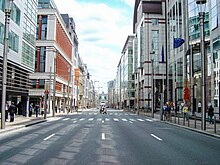Rue de la Loi
 The Rue de la Loi/Wetstraat looking west from over the Belliard tunnel | |
| Location | City of Brussels, Brussels-Capital Region, Belgium |
|---|---|
| Quarter | Leopold Quarter |
| Coordinates | 50°50′39″N 4°22′31″E / 50.84417°N 4.37528°E |
The Rue de la Loi (French: [ʁy d(ə) la lwa]) or Wetstraat (Dutch), meaning "Law Street", is a major street running through central and eastern Brussels, Belgium, which is famous due to the presence of several notable Belgian and European Union (EU) governmental buildings. The road runs from the Rue Royale/Koningsstraat in central Brussels to the Robert Schuman Roundabout in its European Quarter. It forms the first (westerly) part of the N3 road that runs to Aachen, Germany.
The terms Rue de la Loi in French or Wetstraat in Dutch are used metonymically for government in Belgian politics and media because the Belgian Federal Parliament building (Palace of the Nation) stands at the beginning of this street and the office of the Prime Minister is located adjacent to this building, at number 16. It is also where the Council of Ministers holds its meetings.
At the far end, next to the Schuman Roundabout, are the Berlaymont building of the European Commission, the Europa building of the European Council and Council of the European Union, and the Parc du Cinquantenaire/Jubelpark beyond that. Shortly before the roundabout is the exit ramp from the tunnel under the roundabout and Cinquantenaire.
History
[edit]The Rue de la Loi was laid out by the French architect Gilles-Barnabé Guimard in his overall project of Brussels Park and its surroundings, in order to link the Rue Royale/Koningsstraat to the Rue Ducale/Hertogstraat on the northern side of the park. This section was originally called the Rue de Brabant/Brabantstraat ("Brabant Street") because of the neoclassical palace that was built there from 1779 to 1783, opposite the park's main entrance on that side, to accommodate the meetings of the Council of Brabant (see Palace of the Nation). The street acquired its current name in 1797, under the French regime.[1]
The road was redeveloped into a higher capacity one-way thoroughfare in 1969 with the first metro line being built under it, along with two decks of underground parking between the metro line and the road. In 2001, it was proposed that one of the five traffic lanes should be removed and the pavements widened to include cyclepaths. This, together with an overall facelift, was completed on 7 September 2003. Immediately, there were calls for the reversal of traffic flow (see redevelopment below).[2]
Buildings
[edit]
The street starts as a continuation of the Rue des Colonies/Koloniënstraat at the crossroads with the Rue Royale/Koningsstraat. Immediately to the south is Parc/Park metro station and Brussels Park. To the north is the Belgian Parliament building, the Palace of the Nation. The Royal Park Theatre is also situated there.
- No. 10: Office of the president of the Belgian Federal Chamber of Representatives
- No. 16 (north): Official seat of the Prime Minister of Belgium, colloquially called Law Street 16 (French: 16, rue de la Loi, Dutch: Wetstraat 16)
- ~ Avenue des Arts/Kunstlaan (Small Ring) and Arts-Loi/Kunst-Wet metro station (lines 1, 2, 5 and 6)
- No. 41 (south): European Commission (DEVCO)
- No. 44 (north): Touring Club Royal de Belgique
- No. 56 (north): European Commission
- ~ No. 2 rue de Spa/Spastraat (north): European Commission[a]
- ~ No. 3 rue de Spa/Spastraat (north): European Commission[a]
- No. 86 (north): European Commission
- No. 71 (south): Thon Hotel
- No. 89: CD&V headquarters (largest Belgian political party between 1945 and 2010)
- No. 102 (north): European Commission
- No. 130 (north): European Commission[b]
- ~ Maelbeek/Maalbeek metro station (lines 1 and 5)
- ~ Chaussée d'Etterbeek/Etterbeeksesteenweg
- ~ (north) Jardin du Maelbeek/Maalbeektuin
- No. 145 (south): Lex building, offices of the Council of the European Union
- No. 170 (north): Charlemagne building, foreign affairs departments of the European Commission
- ~ Schuman station (heavy rail)
- No. 155 (south): Europa building, headquarters of the European Council and Council of the European Union
- ~ Belliard tunnel exit
- No. 200 (north): Berlaymont building, headquarters of the European Commission
- No. 175 (south): Justus Lipsius building, office space for the Council Secretariat and used for low-level Council meetings.
- ~ Schuman station (metro, lines 1 and 5)
- ~ Robert Schuman Roundabout
Redevelopment
[edit]
As part of plans to improve the image of the European Quarter, the eastern part of the Rue de la Loi (between the Small Ring and the Chaussée d'Etterbeek) will be rebuilt. In April 2008, the Brussels-Capital Region (the regional authority), together with the European Commission and the City of Brussels (the local authority) launched an international urban design competition to redevelop the area as an eco-district, concentrating on improving pedestrian and public transport access. They stated it should include more public spaces and have a "strong symbolic identity" with high environmental and architectural standards. Furthermore, they aimed to diversify the area by bringing in more housing, cultural and leisure areas while simultaneously increasing the area occupied by the Commission from 170,000 m2 (1,800,000 sq ft) to 400,000 m2 (4,300,000 sq ft) – doubling the building density along the street.[3]
In March 2009, a French-Belgian-British team led by the French architect Christian de Portzamparc won the competition, and European Commissioner for Administrative Affairs, Audit and Anti-Fraud, Siim Kallas, stated that the project, which would be put into action gradually rather than all at once, would create a "symbolic area for the EU institutions" giving "body and soul to the European political project" and providing the Commission with extra office space. The road would be reduced from four lanes to two, and be returned to two-way traffic (rather than all west-bound) and the architects proposed a tram line to run down the centre. A series of high-rise buildings would be built on either side with three 'flagship' skyscrapers at the east end on the north side. Then Brussels Minister-President, Charles Picqué, described the towers as "iconic buildings that will be among the highest in Brussels" and that "building higher allows you to turn closed blocks into open spaces."[4][5] The tallest towers at the eastern end would be subject to a separate architectural competition and would be symbolic of the Commission.[6] The freed-up space (some 180,000 m2 (1,900,000 sq ft)) would be given over to housing, shops, services and open spaces to give the area a more "human" feel.[7] A sixth European School may also be built. On the western edge of the quarter, on the Small Ring, there would be "gates to Europe" to add visual impact.[8]
The general quarter master plan saw not only the road being reduced from four lanes to two, but the tunnel's entrance being covered as far as the Résidence Palace, as well as the construction of a new square between the Rue d'Arlon/Aarlenstraat and the Rue de Trêves/Trierstraat.[7]
See also
[edit]- List of streets in Brussels
- Rue Belliard/Belliardstraat, a street running parallel to the Rue de la Loi
- History of Brussels
- Belgium in the long nineteenth century
References
[edit]Footnotes
[edit]Citations
[edit]- ^ "Rue de la Loi – Inventaire du patrimoine architectural". monument.heritage.brussels (in French). Retrieved 25 March 2023.
- ^ Demey 2007, p. 388.
- ^ Operation facelift begins : launch of an urban design competition on a European and international scale, relating to the rue de la Loi and its surroundings, European Commission
- ^ Brussels' EU quarter set for 'spectacular' facelift, EurActive
- ^ "Charlespicque.be" (PDF). Charlespicque.be. Retrieved 3 October 2013.
- ^ "Annonce du lauréat de la compétition visant la Définition d'une forme urbaine pour la rue de la Loi et ses abords" (PDF). Pourbruxellesavecvous.be. Archived from the original (PDF) on 5 October 2013. Retrieved 3 October 2013.
- ^ a b "EU promises 'facelift' for Brussels' European quarter". EurActiv. 6 September 2007. Retrieved 27 September 2007.
- ^ Clerbaux, Bruno. "The European Quarter today: Assessment and prospects" (PDF). European Council of Spatial Planners. Archived from the original (PDF) on 9 April 2008. Retrieved 9 December 2007.
Bibliography
[edit]- Demey, Thierry (2007). Brussels, capital of Europe. S. Strange (trans.). Brussels: Badeaux. ISBN 978-2-9600414-6-0.
External links
[edit] Media related to Rue de la Loi/Wetstraat at Wikimedia Commons
Media related to Rue de la Loi/Wetstraat at Wikimedia Commons- European Commission
- Council of the European Union
- Federal Parliament of Belgium
- Pictures of Rue de la Loi


